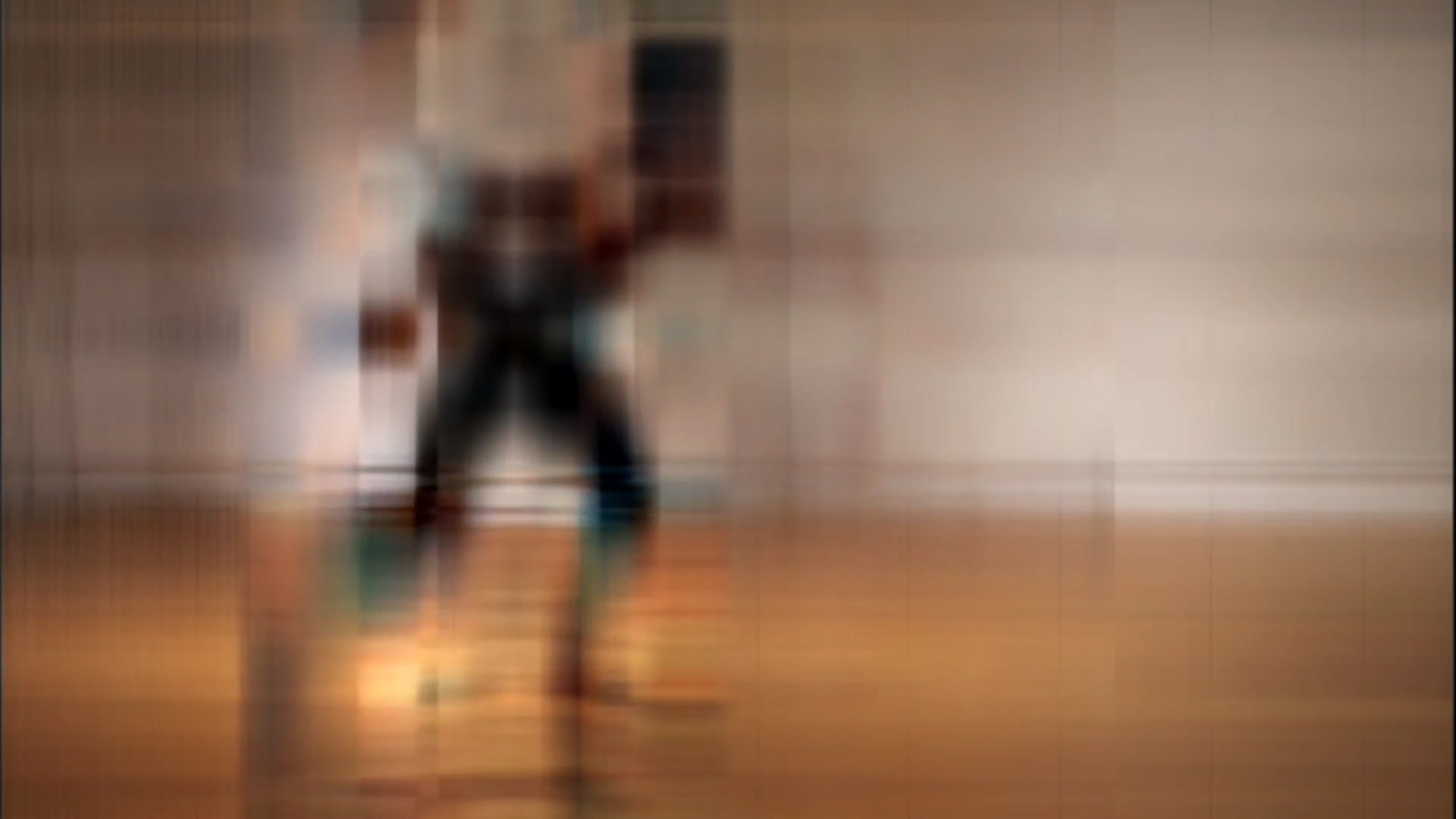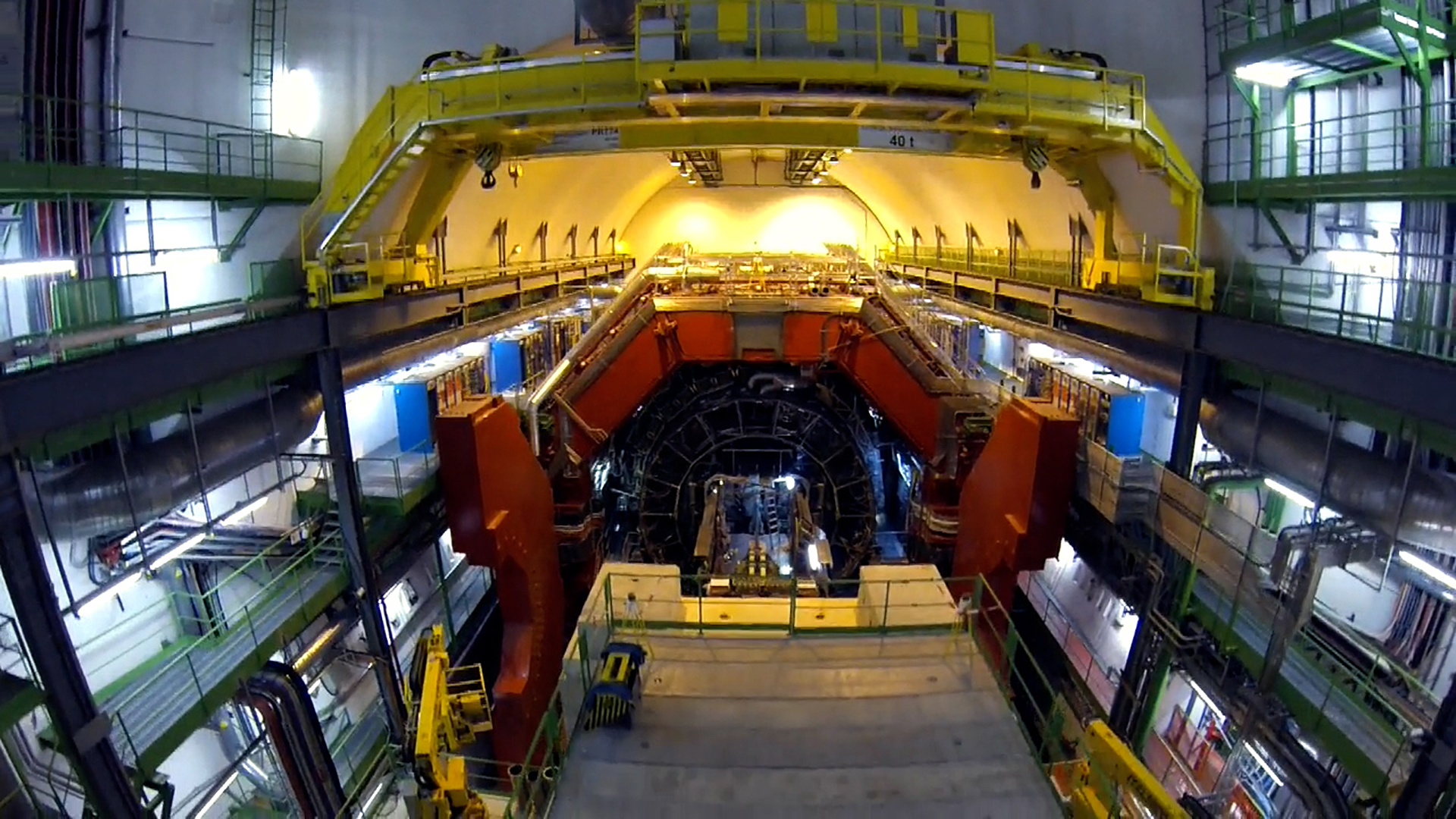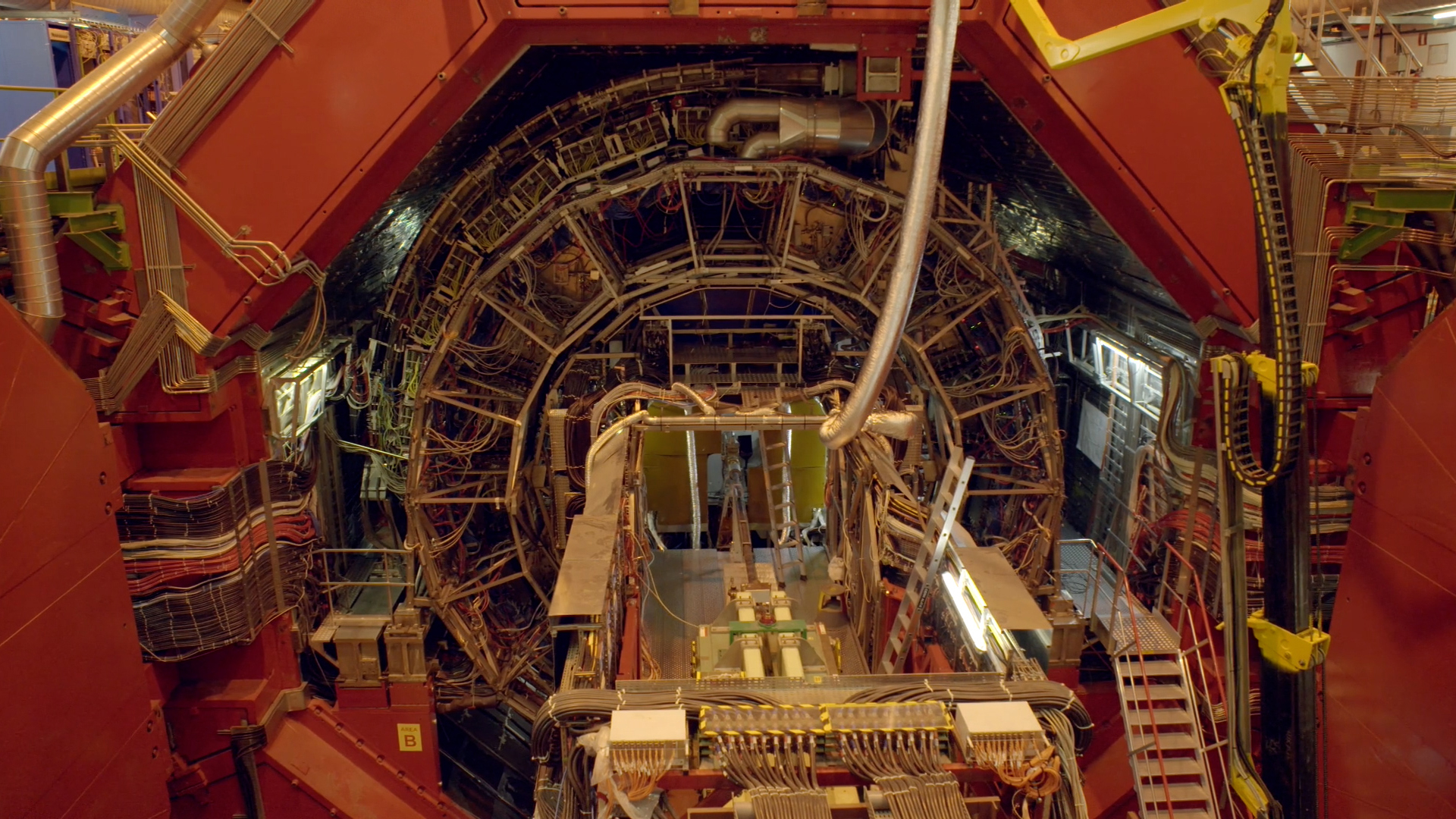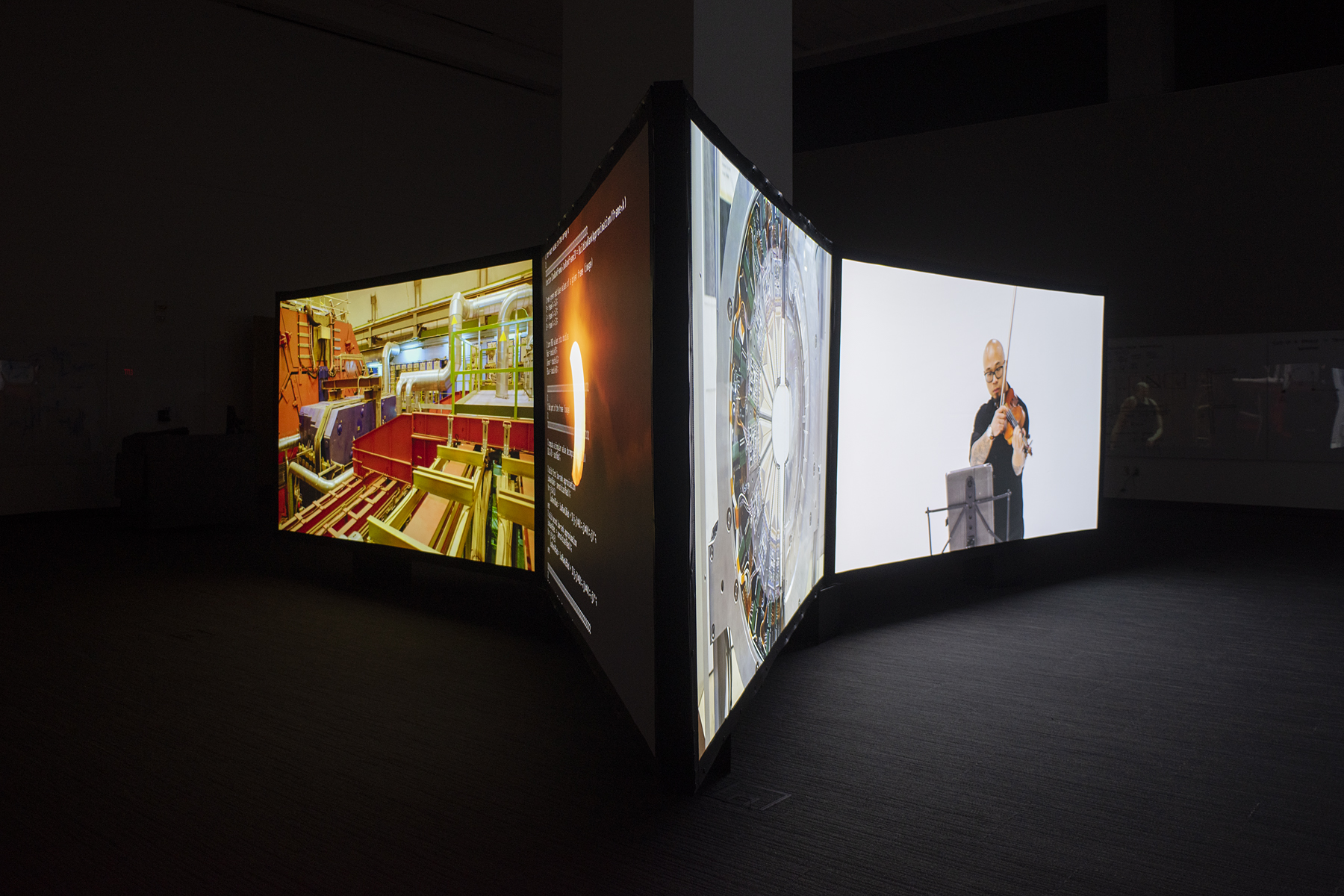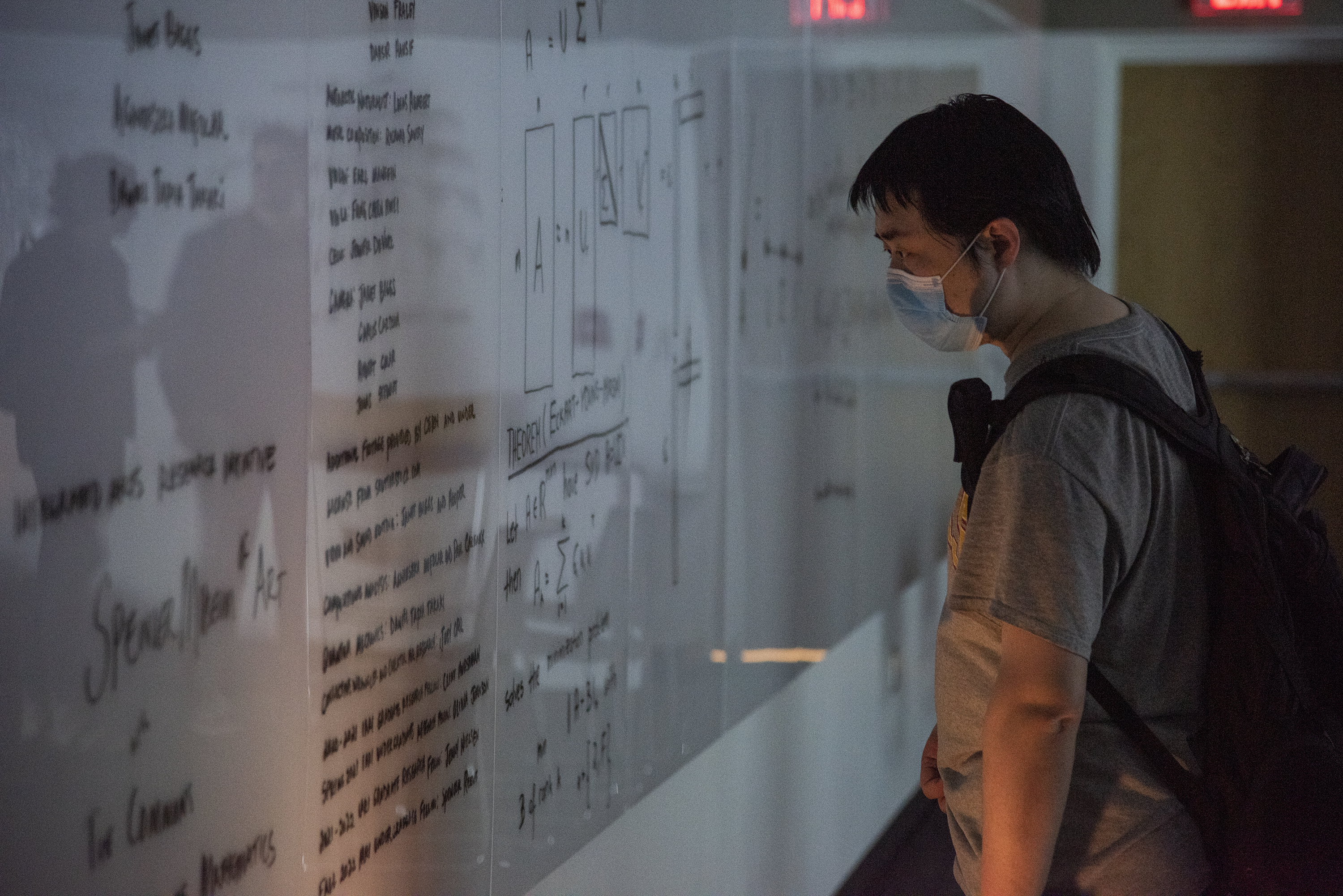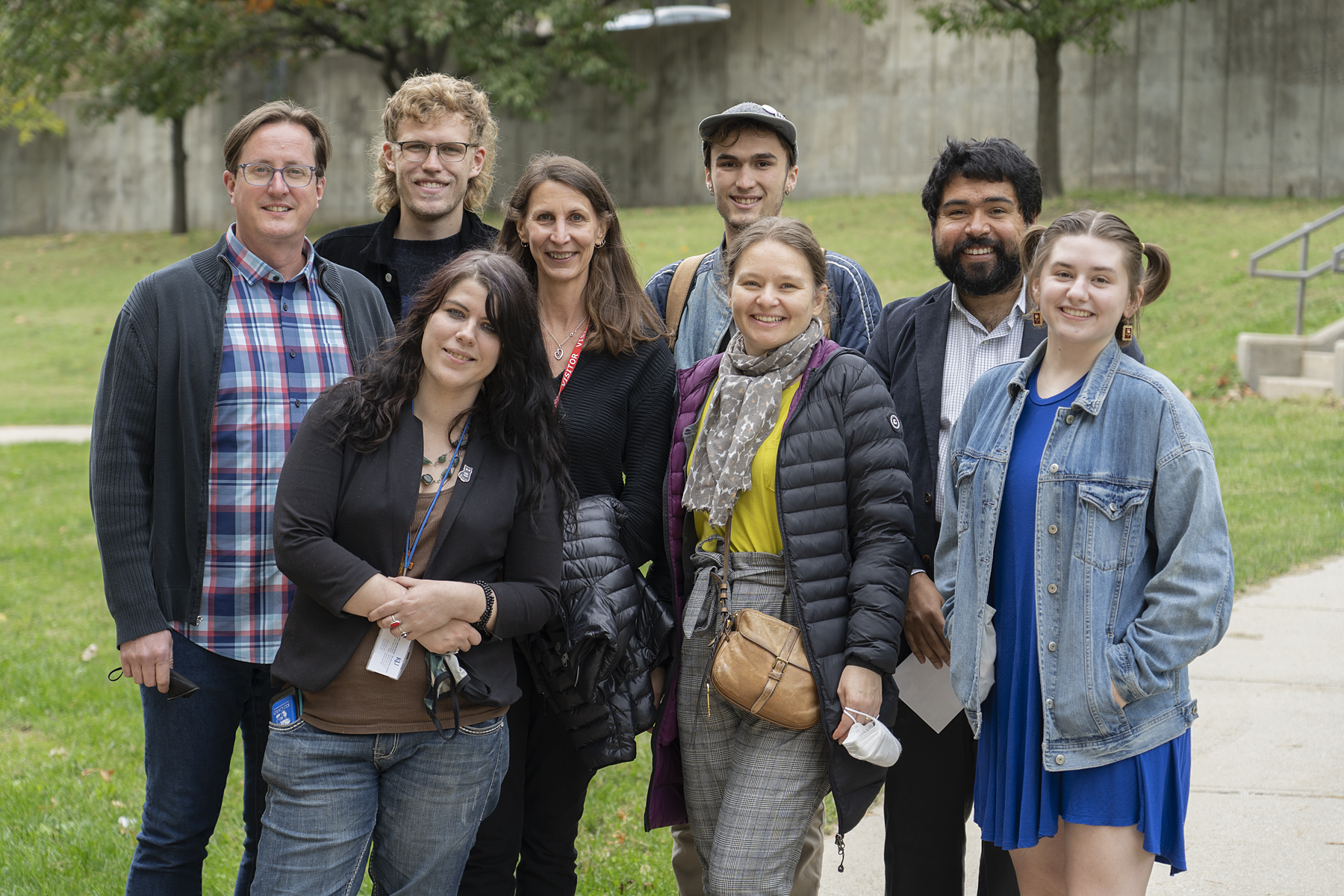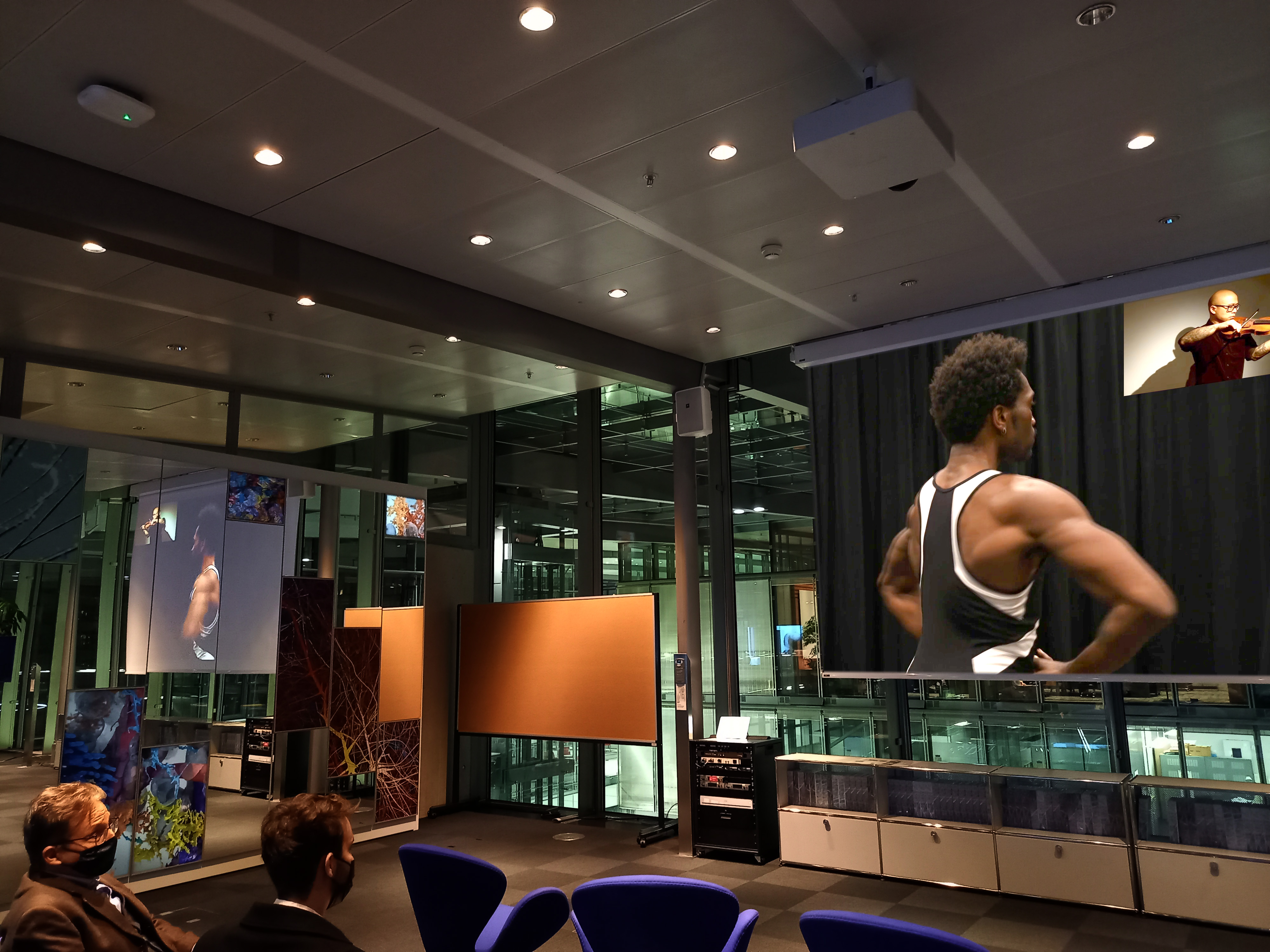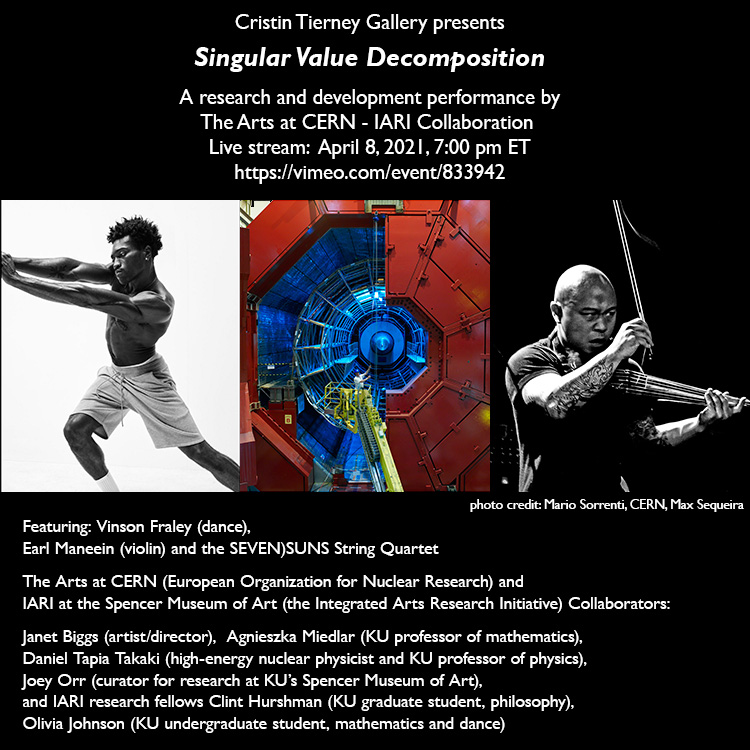COLLECTIVE ENTANGLEMENTS
In the physical sciences, entanglement refers to sets of data that cannot be described independently of one another. In a more general sense, it refers to a complicated relationship or complex situation. It can be very useful in describing interdisciplinary inquiry, as well.
Artist Janet Biggs, mathematician Agnieszka Międlar, and physicist Daniel Tapia Takaki, who leads the University of Kansas’s (KU) team for the ALICE collaboration at CERN’s Large Hadron Collider (LHC), are collaborating on a project that uses time-based media to explore questions in high energy physics and applies novel mathematical techniques to the production of video and performance. Supported by the Integrated Arts Research Initiative (IARI) at the Spencer Museum of Art at KU, this is the first inquiry from IARI whose interdisciplinary group of collaborators aims to produce work collectively.
Collective Entanglements, six-channel, high definition video installation with sound and an interactive whiteboard. 2022. Running time: three endless loops, 05:08 each, total running time 15:24.
On view | Beren Center, Slawson Hall G192, 1420 Naismith Dr
Wednesday–Friday, April 20–22: 10:00 am–5:00 pm
Saturday–Sunday, April 23–24: 10:00 am–2:00 pm
1:00–2:00PM | Beren Center, Slawson Hall G192, 1420 Naismith Dr
Collective Entanglements: Janet Biggs (artist, New York), Agnieszka Międlar (KU Mathematics), Daniel Tapia Takaki (KU Physics). Moderated by Emily Ryan (Director, The Commons)
Collaborative partners on IARI’s 2021–2022 inquiry explore their process and the ideas that continue to drive their work. This program is set within the group’s video installation, which can be viewed before and after the program.
4:00–5:00PM | The Commons, 1340 Jayhawk Blvd
Roger Malina Keynote: Less and Less and More and More
With a background in physics and work with NASA, Roger Malina is now immersed in new research that combines different disciplines for problems that cannot be solved by deep disciplinary expertise. Expanding on scientists’ collaboration with musicians and sound artists, Malina shows how to analyze data by listening to it. Through a kind of “data stethoscope,” we can hear patterns in data that cannot be seen in data visualization.
Roger Malina (Arts and Technology, University of Texas at Dallas) is an art-science researcher, educator, editor, and astrophysicist. He co-founded the University of Texas Dallas ArtSciLab (ASL) where they enable and incubate collaboration between scientists and artists as well as other hybrid projects ASL also carries out research in experimental publishing and curating in collaboration with MIT Press and Leonardo/ISAST at Arizona State University and OLATS in Paris.
10:00–11:00AM | The Commons, 1340 Jayhawk Blvd
Graduate Student Panel on the Philosophy of Science: Polo Camacho (KU Alumnus, Center for Practical Bioethics), Clint Hurshman (KU Philosophy), Jenny Nielsen (KU Philosophy). Moderated by John Symons (KU Philosophy)
Three IARI graduate research fellows have come from KU’s Department of Philosophy, each pursuing projects in the philosophy of science. Together they explore the museum as a space for applied philosophy.
11:30AM–12:30PM | Spencer Museum of Art, 1301 Mississippi St.
Connections with Arts and Sciences from the Spencer Museum’s Collection
Partners on IARI’s 2021–2022 inquiry have selected objects from the Spencer Museum’s collection to display in the Brosseau Learning Center. During this hour join a casual conversation about how their selections relate to their own research and ideas about the philosophy of science.
1:30–2:30PM | Beren Center, Slawson Hall G192, 1420 Naismith Dr
Collective Entanglements, Part 2: Janet Biggs (artist, New York), Agnieszka Międlar (KU Mathematics), Joey Orr (Spencer Museum of Art), Daniel Tapia Takaki (KU Physics). Moderated by Emily Ryan (Director, The Commons)
Partners on IARI’s 2021–2022 inquiry further explore their interdisciplinary process with Spencer Museum Curator for Research Joey Orr. This program is set within the group’s video installation, which can be viewed before and after the program.
4:00–5:00PM | The Commons, 1340 Jayhawk Blvd
Tim Davis Keynote: Math, Matrices, and Music
We know what music sounds like, but if you could see music drawn, what would it look like? In collaboration with Yifan Hu at Yahoo! Labs, Tim Davis’s collection of matrices are converted into images via a physics simulation. Davis has constructed a mathematical algorithm for converting an entire piece of music into a sparse matrix, capturing its essence in a single image. This talk is part of the Spring 2022 Smith Colloquium in Mathematics.
Tim Davis (Computer Science and Engineering, Texas A&M University) created the widely used sparse matrix algorithms and software that used by an array of commercial, government, and open source applications, including Apple, Facebook, Google, MATLAB, and many more. He creates algorithmic art from music and his artwork appeared on billboards across London during the 2013 London Electronic Arts Festival. This talk is part of the Spring 2022 Smith Colloquium in Mathematics.
10:00AM–11:00AM | Beren Center, Slawson Hall G192, 1420 Naismith Dr
Coffee and conversation
11:00AM–12:00PM | Beren Center, Slawson Hall G192, 1420 Naismith Dr
Collective Entanglements Public Roundtable: Janet Biggs, Tim Davis, Roger Malina, Agnieszka Międlar, Joey Orr, Daniel Tapia Takaki
IARI inquiries typically conclude public programming with a roundtable discussion. No one contributor holds the floor, and everyone present is warmly invited to participate in the conversation. This program is set within the group’s video installation, which can be viewed before and after the program.
2:30PM–6:00PM | Beren Center, Slawson Hall G192, 1420 Naismith Dr
Exhibition on view + Closing reception
Clint Hurshman and Joey Orr's co-authored article, "How to Do Things with SVD: Mathematical Tool-Sharing from Physics to Peformative Research," was published in Leonardo (MIT Press) October 2022, Volume 55, Issue 5.
On September 2, 2022, Arts at CERN published an interview with the collaborators. Read it here.
On Monday, May 4, 2022, the collaborators worked with Ground Works and the Alliance for the Arts in Research Universities (a2ru) to present "Work in Progress: A Ground Works Panel Discussion on Art-Science Collaboration." Janet Biggs, Agnieszka Miedlar, Joey Orr, and Daniel Tapia Takaki were joined by Monica Bello, Head of Arts at CERN, for a conversation about interdisciplinary team work. The presentation can be accessed here.
On Tuesday, March 29, 2022, the collaborators presented on the video documentation of their work, Singular Value Decomposition, at Campus Biotech in Geneva, Switzerland, in conjunction with the exhibition in Memoriam: anni horribles, 2020-2021. The exhibition was on view November 2021-January 2022.
On Thursday, April 8, 2021, the collaboration's live-streamed performance, Singular Value Decomposition, was presented by the Cristin Tierney Gallery in New York at ONX Studio. Below is edited documentation of the work.
On Wednesday, October 28, 2020, the collaborators presented their work-in-progress for a live peer-review session with Ground Works, a compendium of arts inclusive, collaborative research projects supported by the Alliance for the Arts in Research Universities (a2ru).
The collaborators submitted their project and working questions through a Letter of Interest to Snowmass, the Particle Physics Community Planning Exercise held by the American Physical Society Division of Particles and Fields.
The CERN-IARI Project and New Opportunities for Integrated Arts Research Collaborations at Universities and National Laboratories
Authors: Mónica Bello1, Janet Biggs2, Agnieszka Miedlar3, Ágnes Mócsy4, Joey Orr5, John P. Ralston6, and Daniel Tapia Takaki6
Endorsements: Paul Ardenne7, Purnaprajna Bangere3, Paul Cazeux3, Tamara Falicov8, Maryrose Flanigan9, Kevin Hamilton10, Lynn Hershman Leeson11, Toby Jurovics12, Mark Levinson13, Walter Melion14, Pa- tricia Olynyk15, Joonha Park3, Barbara Polla16, Saralyn Reece Hardy17, Asher Remy-Toledo18, Danielle Siembieda19, Veronica Stanich9, Celka Straughn5, Daniel Szyld20, Lisa Tedesco14, Kelsa Trom21, and Roel Van Beeumen22.
- CERN, Arts at CERN, 1211 Geneva, Switzerland;
- Visual Artist, Brooklyn, NY 11211, USA;
- Department of Mathematics, The University of Kansas, Lawrence, KS 66045, USA;
- Pratt Institute, Brooklyn, NY 11205, USA;
- Spencer Museum of Art, The University of Kansas, Lawrence, KS 66045, USA;
- Department of Physics and Astronomy, The University of Kansas, Lawrence, KS 66045, USA;
- Professor of History, The University of Amiens, Art Critic and Curator in the field of contemporary art, Amiens, France;
- Associate Dean for Research, Arts and Humanities, CLAS, The University of Kansas, KS 66045, USA;
- Executive Director, Alliance for the Arts in Research Universities (A2ru), Ann Arbor, MI 48109, USA;
- Dean, College of Fine and Applied Arts, University of Illinois at Urbana-Champaign, Champaign, IL 61820, USA;
- Artist Filmmaker, Professor Emeritus, University of California Davis, Davis, CA 95616, USA;
- Director, Barry Lopez Foundation for Art & Environment, Coyote, NM, USA;
- Director/Producer of Particle Fever, New York, NY, USA;
- Emory University, Laney Graduate School and Fox Center for Humanistic Inquiry, Atlanta, GA 30322, USA;
- Director, Creative Research Institute, Director of Graduate School of Art, Florence and Frank Bush Professor of Art, Washington University in St. Louis, St. Louis. Co-director, the Leonardo/ISAST, NY LASER, New York, USA;
- Gallery Owner, Analix Forever, 1225 Chêne-Bourg, Switzerland;
- Director, Spencer Museum of Art, The University of Kansas, Lawrence, KS 66045, USA;
- Director, Hyphen Hub, NY 10011, USA;
- Managing Director, Leonardo/ISAST, Oakland, CA 94612, USA;
- Department of Mathematics, Temple University, Philadelphia, PA 19122-6094, USA;
- Head of Programs, NEW INC, New Museum, New York, NY 10002, USA;
- Research Scientist, Berkeley Lab, Berkeley, CA 94720-8150, USA.
Abstract: Recent collaborative work between scientists and artists has opened new perspectives in how multidisciplinary collaborations can be carried out between fields that are often considered to be orthogonal to each other. Physicists working in the field of fundamental physics at CERN and other U.S-based national laboratories and institutions have engaged in such projects in recent years. At the same time, there are ongoing programs in the field of contemporary arts on how to conduct true research among artists and scientists. The University of Kansas via the Integrated Arts Research Initiative has provided some novel ideas on how such collaborations can be established and expanded. We describe the current status and projects between physicists, mathematicians, visual artists, and curators from CERN, the University of Kansas Department of Physics and Astronomy, Department of Mathematics, and Spencer Museum of Art. We highlight the impact that educational projects with social engagement can have for multiple fields.
Introduction. In recent years several university groups and national laboratories working in the field of fundamental physics have developed educational materials, lectures, and dedicated programs that link the arts and sciences. CERN has created a dedicated program called Arts at CERN1 that has proven to be very successful in establishing collaborations between artists and particle and nuclear physicists. This has been done via a residency arts program and several open competitions, which have resulted in exhibitions and artwork that have been displayed at CERN, universities, and art galleries around the world. U.S.- based national laboratories, like Fermilab and Brookhaven, have also developed similar programs. Such initiatives are not unique to the field of fundamental physics. Yet particle and nuclear physics research has been very appealing to artists because of the ideas, methods, and inspiration of physicists wanting to answer fundamental questions of the Universe and because this research has a strong interdisciplinary component. It has, therefore, attracted the attention of the public and the art community, especially after recent findings like the Higgs boson, searches for physics beyond the standard model, and quark-gluon plasma studies. Physicists are also fascinated by the laws that govern the dynamics of the Universe and the possible connections of such ideas, methods, and findings with contemporary art.
Several dedicated professional conferences have led recent work in this direction. For example, in 1998 at Southwestern College in Winfield, Kansas, Reza Sarhangi organized the first Bridges Mathematics, Art, Music, Architecture, Education, Culture annual conference to bring together artists and scientists interested in pushing the boundaries and exploring unknown territories. Since then, “the goal of the Bridges Organiza- tion is to foster research, practice, and new interests in mathematical connections to art, music, architecture, education, and culture”2. In 2010, the Museum of Science, Boston, launched the NSF-funded project Di- mension of Public Engagement with Science to engage in the dialogue between scientists and the broader public on the social values of scientific discoveries, stimulate public interest and understanding of science, and provide new perspectives on scientific research by increasing the participation of a diverse public.
The University of Kansas (KU) has developed several collaborative projects between artists and scientists and has been participating in the Arts at CERN project. KU is unique in the United States thanks to pro- grams led by the Spencer Museum of Art (SMA) in collaboration with other units, such as the Department of Physics and Astronomy and the Department of Mathematics, together with both domestic and international artists. KU has established the Integrated Arts Research Initiative (IARI)3 to infuse the arts into the research culture of KU by advancing interdisciplinary projects across the sciences and humanities in collaboration with the SMA. To this end, IARI supports one inquiry each academic year that is broadly enough conceived to address practitioners from a range of fields. Artistic practice is understood as a research method and inte- grated into the inquiry from its conception. IARI rethinks the academic art museum as an active participant in research across the sciences and humanities. It positions the museum to thoughtfully participate in the formulation of research questions and the methods that produce knowledge. As an art museum initiative, IARI also conceives of artistic practice as its own method of knowledge production. IARI, therefore, invites artists and academics to engage in research together and consider how being in conversation with differ- ent methods can inform research across disciplines. IARI is currently supporting a collaborative inquiry among four different researchers: Janet Biggs (visual artist), Agnieszka Mie˛dlar (mathematician), Joey Orr (curator), and Daniel Tapia Takaki (physicist), in collaboration with Mónica Bello from the Arts at CERN. This collective aims to use the time-based medium of film and video as a particular kind of data set to ad- dress problems and questions in the field of fundamental physics, including particle, nuclear, and quantum mechanics, applying several novel mathematical methods. The inquiry enables each collaborator to use methods derived from their respective fields to explore shared questions among the group. It also opens possibilities to engage with a broad spectrum of researchers, from video artists and curators to physicists, mathematicians, philosophers, and others. From a broader perspective, rigorous inquiries that integrate a spectrum of practices can help formulate institutional research values in ways that address the complexities of our emerging contemporary contexts. This work is signaled in the larger field by such organizations as the Society for Artistic Research and the Alliance for the Arts in Research Universities, and in such schol- arly journals as the Journal for Artistic Research and Leonardo. By conveying, constructing, disrupting, and redefining practices, protocols, and assumptions across physics, computational mathematics, and the fine arts, our current collaboration strives to expand the scope of the potential made possible through mul- tiple perspectives and voices. We are exploring intrinsic links between physics, mathematics, and the arts through experimentation and play, as well as rigor and scholarship. We ourselves, and by extension a broad cross-disciplinary audience, are finding excitement and impact in the creation of a culture of questioning.
Research Inquires. Some of our research questions include:
• Can physics and mathematics be embedded in the process of and integral to a work of art?
• Can artists use physics and mathematics to make an artwork?
• Can physicists and mathematicians be inspired by art to build new scientific knowledge?
• Can art revolutionize the transmission of mathematical concepts of the physical universe to students and the public?
• Can collaboration across disciplines be generative and substantive in the respective fields?
• Can IARI trigger opportunities and engagement across education and research institutions?
• Can art, mathematics, and physics guide research across fields of inquiry?
• Can the arts and sciences both advance understanding as science and creative practice?
Public Outreach and Educational Opportunities. Visual art is an excellent communication tool. It has been used to expose general audiences to the sciences and humanities in many ways. For example, Particle Fever (2013) directed by Mark Levinson used documentary film making to reveal the first round of experi- ments at CERN’s Large Hadron Collider. In the field of nuclear physics, physicists Ágnes Mócsy has made the documentary Smashing Matters: Behind the Science Scene that has triggered educational projects on art and sciences, as well as collaborations between artists 15;16 and students 17;18. The Exploratorium museum of science, technology, and art is an example of a museum with a sole mission to create public experiences of art and science integration.
The SMA regularly partners with researchers on the Broader Impacts section of grants to the National Science Foundation. Through IARI, the museum specifically makes the case that artists themselves are researchers. In 2019, the museum mounted a major exhibition, knowledges, funded by the National Endow- ment for the Arts that looked at artistic practice as research method. In coordination with the exhibition, the museum also produced a publication, Inquiries, and several short-format documentaries that captured the work of contemporary artists working across several knowledge domains. This work was also the focus of the national convening for the Alliance for the Arts in Research Universities, an organization that supports a full range of arts-integrative research. An inquiry from this work will be organized for the 2021-2022 academic year, including an exhibition.
We anticipate that the CERN-IARI project will serve as a model for future science-arts collaborations in fundamental physics, mathematics, and other fields. And new educational and outreach projects will follow from this work.
1https://arts.cern/
2http://bridgesmathart.org
3https://spencerart.ku.edu/integrated-arts-research-initiative
References
[1] Allegue, Ludivine, Simon Jones, Baz Kershaw, Angela Picini. Eds. Practice-as-Research in Perfor- mance and Screen. Hampshire and New York: Palgrave Macmillan, 2009.
[2] American Mathematical Society (AMS). "Mathematical Imagery". http://www.ams.org/ publicoutreach/math-imagery/math-imagery.
[3] Balkema, Annette W. and Henk Slager. Eds. Artistic Research. Amsterdam and New York: Rodopi. (Lier en Boog Series of Philosophy of Art and Art Theory, Volume 18), 2004.
[4] Barrett, Estelle and Barbara Bolt. Eds. Practice as Research: Approaches to Creative Arts Inquiry.. London and New York: I.B. Taurus, 2007.
[5] Bell Larry, Caroline Lowenthal, David Sittenfeld, Katie Todd, Sarah Pfeifle, and Elizabeth Kunz Koll- mann. Public Engagement with Science: A guide to creating conversations among publics and scien- tists for mutual learning and societal decision-making. Museum of Science, Published under a Creative Commons Attribution Noncommercial-ShareAlike license, 2017.
[6] Biggs, Michael and Henrik Karlsson. Eds. The Routledge Companion to Research in the Arts. London and New York: Routledge, 2011.
[7] Borgdorff, Henk. “The Debate on Research in the Arts” in Sensuous Knowledge Focus on Artistic Research and Development, No. 2. Bergen National Academy of the Arts, 2006.
[8] Dean, Roger T. and Hazel Smith. “Practice-led Research, Research-led Practice in the Creative Arts". Edinburgh University Press, Edinburgh, UK, 2009.
[9] Eremenko, Ekaterina. "Colors of Math". Documentary, Adventure. Finland, 2012.
[10] Haseman, Brad. “A Manifesto for Performative Research”. Media International Australia, vol. 118: 98–106, 2006.
[11] Holtz, Olga. "The Zahir". Short, Drama, Mystery. USA, 2014.
[12] Macleod, Katy and Lin Holdridge. Eds. “Thinking Through Art: Reflections on Art as Research". (Innovations in Art and Design Series). London and New York: Routledge, 2006.
[13] Rose Riley, Shannon and Lynette Hunter. Eds. “Mapping Landscapes for Performance as Research: Scholarly Acts and Creative Cartographies.". Hampshire and New York: Palgrave Macmillan, 2009.
[14] Jackson, Shannon. “Social Works: Performing Art, Supporting Publics". New York and London: Rout- ledge, 2011.
[15] Mócsy, Ágnes. "The Unforeseen”. Collaborative STEAMplant art project with Pamela Breda and Ira Livingstone, 2019. https://commons.pratt.edu/steamplant/ project-the-unforeseen/.
[16] Mócsy, Ágnes. “Space Between Spaces”. Collaborative STEAMplant art project with Joseph Morris and Che-Wei Wang, 2018-2019. https://commons.pratt.edu/steamplant/ project-a-space-between-spaces/.
[17] Mócsy, Ágnes. “Glamorous Gluons”. Collaborative art project and show with Sarah Szabo, 2014.
https://www.bnl.gov/newsroom/news.php?a=25002
[18] Mócsy, Ágnes. “Sound of the Little Bangs”. Collaborative work with Alexander Doig andPaul Sorensen, 2010. https://www.youtube.com/watch?v=jF8QO3Cou-Q and https:
//www.youtube.com/watch?v=Mds4kMAsrLc.

